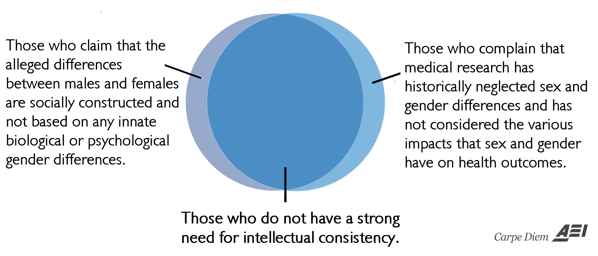
The Venn diagram above was inspired by Heather Mac Donald’s City Journal article “Gender Is a Construct—Except When It’s Not,” here’s a slice:
A foundational tenet of academic feminism holds that alleged differences between males and females are socially constructed. This credo usually maximizes the opportunities for charging sexism, yet it will be discarded in an instant if acknowledging the innate biological and psychological differences between men and women yields an additional trove of feminist complaint. The current issue of the Yale Alumni Magazine shows how the game is played.
For years, medical research neglected “sex and gender differences” in health, according to the magazine. “Historically, the narrative of medicine has been driven by data derived from white men around the age of 40,” the associate dean for curriculum at the Yale Medical School told the magazine’s reporter. Clinical trials only occasionally included females and when they did, the results were rarely analyzed by sex. It’s mysterious why this alleged neglect should matter, if sex differences are “socially constructed.” If males and females are the same psychologically and physically before the patriarchy starts assigning sex roles, then medical research need not distinguish between males and females, either.
It turns out, however, that males and females differentially respond to stress, environmental risk factors, drugs, and disease, as an initiative called Women’s Health Research at Yale devotes itself to documenting. Among the relevant findings:
- Two-thirds of all Alzheimer’s patients are female;
- Seventy-five percent of people with autoimmune disorders are female;
- Females are less likely to develop Parkinson’s disease;
- Adult females have twice the rate of depression as adult males;
- Females have outbreaks of genital herpes at higher rates than males;
- Male and female brains respond differently to early childhood neglect, with males losing gray matter in areas governing impulse control and females losing gray matter in areas governing emotion;
- Women are more likely to abuse alcohol after trauma;
- Males and females smoke for different reasons and have correspondingly different success rates with the nicotine patch;
- The X and Y sex chromosomes, whose pairing determines a person’s sex, influence how the other 23 chromosomes in each cell read the genetic instructions contained in DNA.
Such discoveries should be the death knell for social constructivism. Along with many others like them, they buttress the possibility that uneven sex ratios in various fields are in part the result of males and females’ different average dispositions toward competition, risk, and abstract rather than people-centered work (an observation that got computer engineer James Damore fired from Google).
Via AEI